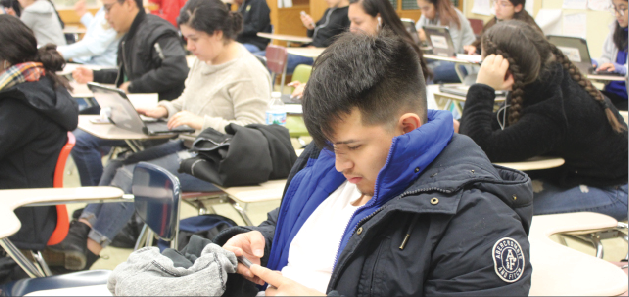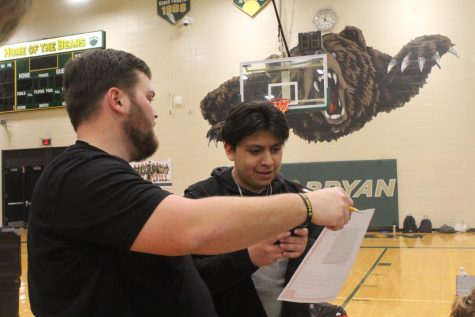Technology plays positive, negative roles in classrooms
During his third block class, Junior Uriel Sanchez watches a video on his phone while his classmates complete their work using laptops from the mobile lab.
December 14, 2018
Phone usage in class is a subject that is very controversial this year for students and teachers. As phones become a bigger part of life, students and teachers alike are depending on them more. Amongst the change is the debate as to whether they are beneficial for students.
U.S. History teacher Angela Kisicki, tries to positively incorporate technology into learning. She uses it for Kahoot, Remind, Forms and many Office 365 apps.
Teachers have students use their phones for different things rather than getting out a laptop or having them do it at home.
“Phones bother me when I am teaching, but otherwise they are not a problem,” Kisicki said.
Phones can take a student from doing work to something totally random, because it is very easy for people to get distracted since a phone is a device that can be used for everything.
“For some students who use them correctly as a learning tool to help them, it doesn’t hurt them,” Kisicki said. “But then you have those kids that are playing games and not using their work time wisely.”
Some teachers have incorporated tech checks and short breaks to allow students the time to check their phones before returning to their classwork. Still, it isn’t uncommon to still see students using their phones while a teacher is teaching.
Students like junior Emilano Carrera-Ybanez admit to having the desire to check their phone, but insists that despite the major role it plays in his life, it does not impede their capability of learning in the classroom.
According to a survey done by the University of Nebraska-Lincoln and published in the Journal of Media Education, students spend 20 percent of their class time on their phones doing unrelated tasks, such as texting and checking social media.
Phones are becoming a part of daily life. Phones are used for anything and everything. Whether it be Netflix, Instagram, or any other social media app, teenagers’ lives revolve around their phone and they rely on it for even the simplest task.
“Phone usage in class can be a bit obsessive at times since many students rely on their phone to comprehend material,” Carrera-Ybanez said. “Phones being used in class should be allowed when it is appropriate or has given purpose in class.”
It’s not just cell phones that are changing the classroom. Since the introduction of the AP and TDL student laptops last year, the school has relied heavily on technology. Victims of the “blue screen of death” last year can remember the constant shutting down and restarting of computers that could sometimes hinder whole blocks of classwork.
With the growing reliance on technology, the school is adapting and compromising with students so devices like phones can be used in positive ways in the classroom.







